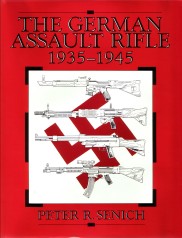 |
Fallschirmjagergewehr 42 (FG 42) |  |
|
|
|
|
CRUFFLER.COM
presents
HISTORIC
FIREARM OF THE MONTH,
November
2000:
 |
Fallschirmjagergewehr 42 (FG 42) |  |
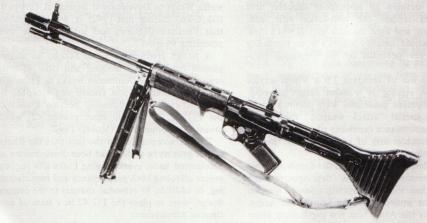
Image credit: Senich, Peter, The German Assault Rifle 1939-1945, Paladin Press, Boulder, Colorado: 1987 Page 240 |
SPECIFICATIONS
Type: Selective Fire Paratroop Rifle System of Operation: Gas, Turning Bolt Caliber: 7.9x57mm Mauser Capacity: 20 round box magazine Sights front: Blade, drift adjustable for windage Sights, rear: Elevation adjustable diopter Length: 37" Weight (unloaded): 9.93 lbs Barrel: 19.75" |
German paratroop units were, unlike their allied counterparts, were not part of the army (Wehrmacht). Rather, they were a specific province of the German air force, the Luftwaffe. These elite Luftwaffe formations were originally provided with the same K98k bolt action carbine, MG34/MG42 machineguns, and MP38/MP40 submachineguns as regular infantry formations. Early combat experiences in World War Two indicated that these weapons were not well suited to the needs and exigencies of airborne assaults. Consequently, the Reichluftsfahrtministerium (RLM), or Reich Air Ministry specified a requirement for a long-range, selective fire rifle that would act as a general purpose shoulder arm, replacing the bolt action rifle, submachinegun and light machinegun. It was hoped that the single arm would simplify logistics while augmenting the individual paratrooper's firepower.
Use of the
standard service 7.9x57mm ammunition was mandatory, and design efforts
went forward with the intent of producing a specialized weapon that would
offer the capabilities of a light machinegun in a package no larger than
an ordinary bolt action rifle. Since the Heereswaffenamt,
the Wehrmacht's Weapons Office was the key player in German small arms
development, the Luftwaffe initially sought to foment the development program
with the Wehrmacht's assistance. The Wehrmacht, however, thought
the project to be specious at best and declined to participate. As
a result, the RLM took the project, lock, stock and barrel, directly to
German weapons manufacturers. The RLM solicited Gustloff, Mauser,
Grossfuss, Haenel, Rheinmetall-Borsig, and Krieghoff to participate in
the FG42 development project. Of these firms, only Krieghoff and
Rheinmetall-Borsig actually submitted prototype weapons based on the Luftwaffe's
requirements.
| The two prototypes were tested by the Luftwaffe Weapons Development Branch (GL/C-E6) at Tarnewitz through the middle of 1942, and the Rheinmetall gun was selected for procurement as the |

Rheinmetall FG42 Prototype Image credit: Senich, Peter, The German Assault Rifle 1939-1945, Paladin Press, Boulder, Colorado: 1987 Page 240 |
The FG42 is a magazine fed, gas operated, turning bolt design that traces its lineage back to the Lewis light machinegun of World War One, and its descendants to the U.S. M60 general purpose machinegun. When the gun was fired, expanding high pressure gasses forced the bullet down the barrel. As the bullet passed the gas port, located approximately one third the barrel's distance from the chamber, some of the high pressure gas was vented into a cylinder beneath the barrel. This gas forced a long gas piston rapidly to the rear. As the piston moved to the rear, its vertical lug engaged a spiral cam slot on the bolt. As the lug moves rearward against the cam slot, the bolt is first rotated, bringing the locking lugs out of their recesses, and the forced to the rear. As the bolt moves to the rear, the fired case is extracted and ejected. The rearward motion of the bolt and piston is arrested by the action of the recoil spring and buffer on the piston. At this point the recoil spring forces the bolt/piston group forward again. As the bolt moves foreward, a fresh cartridge is stripped from the magazine by the bolt into the chamber, and the bolt is then rotated into the locked position.
The FG42's sear mechanism is interesting as it was designed to fire from a closed bolt for semiautomatic fire and an open bolt for fully automatic fire, so as to permit accurate single shots, yet permit the best possible cooling when operating in fully automatic mode. The combination of an in-line stock configuration and side mounted magazine placed both the center of gravity and the center of the butt almost directly in line with the center of the bore, providing a surprising degree of control over a conventional automatic rifle firing a full power service cartridge. As a result, the FG42 was an automatic rifle with the characteristics of a lightweight machine gun with provision for special attachments.
PHYSICAL CHARACTERISTICS - Early FG42
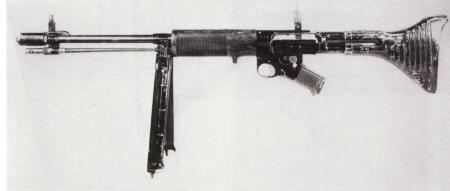
Production Version of Rheinmetall FG42 Image credit: Senich, Peter, The German Assault Rifle 1939-1945, Paladin Press, Boulder, Colorado: 1987 Page 248 |
The prototypes manufactured by Rheinmetall were manufactured largely of chrome steel. While an excellent material for gun manufacture, chrome steel was a strategic alloy in short supply. When the Luftwaffe was permitted to build 3,000 FG42 trials rifles, the material specification was amended to permit manufacture |
Krieghoff took advantage of the production halt to register a major objection to the amount of forging, machining, and close tolerance work necessary to produce the Rheinmetall design. Given the exigencies of wartime production needs, the objection met with significant agreement in German ordnance circles. In addition to the production difficulties, field reports indicated that the FG42's light weight worked against it in the long range, full automatic fire support role. There were also allegations that the gun was simply too fragile for the rigors of sustained combat. Krieghoff was rewarded with a contract to redesign the FG42 so as to simplify production and remedy the basic flaws affecting performance and durability.
The Krieghoff modifications were extensive, affecting almost every aspect of the FG42. Among the most notable changes were:
| While the design of the FG42 didn't lend itself to simple mass production techniques, the Krieghoff gun was a dramatic improvement in production engineering. While the original Rheinmetall design's receiver was a complex forging that called for extensive machining, the new Krieghoff receiver |
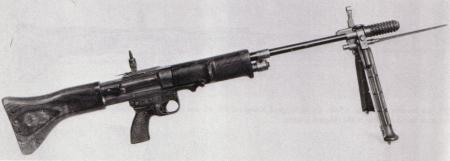
Krieghoff FG42 Image credit: Senich, Peter, The German Assault Rifle 1939-1945, Paladin Press, Boulder, Colorado: 1987 Page 256 |
In effect, these modifications were tacit admissions that the combination of a short barrel, light weight, and a full power cartridge made for a rifle that was very difficult to control. Consequently, further modifications almost always included an increase in system weight. Indeed, the last model FG42 was to be more than two pounds heavier than the first Krieghoff model. Despite this, the rifle suffered from controllability problems up to the end of production. Despite advances in firearms technology and production techniques for fifty years after the FG42's entry into service, the dilemma of controllable, lightweight fully automatic rifle firing a full power service cartridge was never solved. The last generation of full power battle rifles - the FAL, the M14, and the G3 - all suffered from poor controllability in the fully automatic mode.
Given the FG42's inability to supplant the light machinegun, and the comparable performance of the 7.9x33mm Sturmgewehr series of firearms, the Wehrmacht adamantly championed the universal acceptance of the 7.9x33mm weapons and the termination of FG42 production and development. Despite this, the Luftwaffe never officially adopted the short cartridge.
Both the Wehrmacht and the Luftwaffe continued to study and evaluate the FG42 during the length of the its service life. Wehrmacht tests in early 1944 indicated that the FG42 was incapable of replacing the light machinegun. Additionally, the Heereswaffenamt indicated that the FG42 offered no performance advantage over the MP43 out to 400 meters. As a result, the Wehrmacht demanded that the short cartridge assault rifle series be given preference. As the war progressed, the German armed forced stood more and more on a defensive posture. More and more frequently the Fallschirmjager units served as regular infantry, thus obviating the need for a special airborne assault rifle. Despite all this, and for some reason known only to the inscrutable logic of German wartime procurement, the Luftwaffe was given permission to mass produce the FG42 in late 1944. Krieghoff built approximately 5,000 FG42's before wartime exigencies brought production to a halt in early 1945.
FG42's produced
by Krieghoff bear the "fzs" maker code. While this was originally
the code for the Heinrich Krieghoff Waffenfabrik, Suhl, later evidence
suggests that the FG42 was actually developed and produced at what the
German ordnance establishment referred to as Plant No. 10 - Luttich.
Prior to the war Plant No. 10 had been known as the Luttich Plant and was
part of the holdings of the Krieghoff organization, which had purchased
the Liege, Belgium facility in the late 1930's from the Anciens Etablissements
Pieper (makers of the Bayard M1908 pistol) as a means of expanding production
capacity. FG42's were also produced by the L.O. Dietrich firm of
Altenburg (production code gcy), with replacement parts being made by I.C.
Wagner of Mulhausen (production code gal). All told, approximately
7,000 FG42's were made, breaking down to 2,000 early and 5,000 late models.
Most FG42's saw use on the western front during the war.
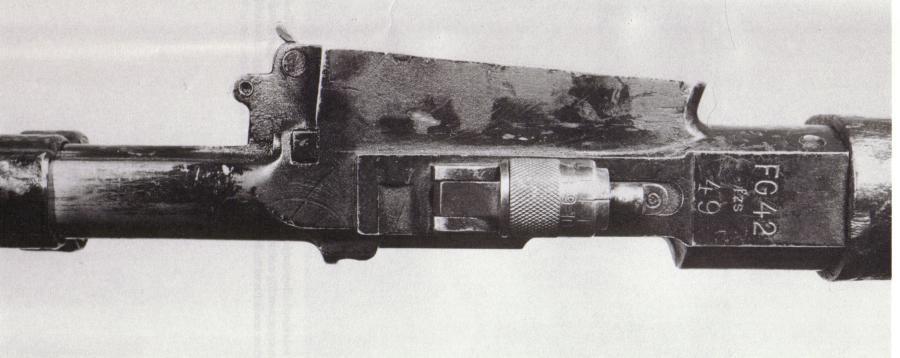
Early fzs Receiver Image credit: Senich, Peter, The German Assault Rifle 1939-1945, Paladin Press, Boulder, Colorado: 1987 Page 243 |
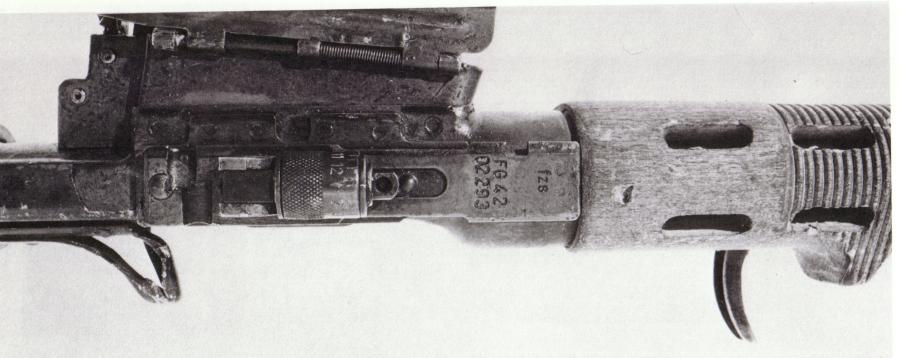
Late fzs Receiver Image credit: Senich, Peter, The German Assault Rifle 1939-1945, Paladin Press, Boulder, Colorado: 1987 Page 265 |
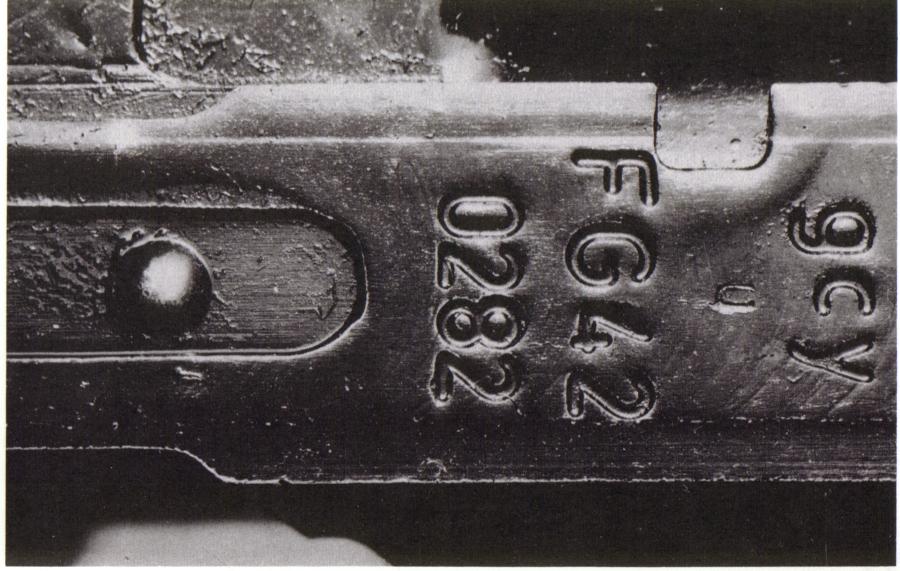
gcy Receiver Image credit: Senich, Peter, The German Assault Rifle 1939-1945, Paladin Press, Boulder, Colorado: 1987 Page 278 |
The FG42, despite being produced in limited numbers, was one of the most influential firearms of the Second World War. The US Army manifested a great deal of interest in the FG42. A post war design project initiated by the US Army Ordnance Corps married the belt feed system of the MG42 with the FG42's operating mechanism. The project was refined for a number of years, and resulted in a direct descendant of the FG42 - one of the most prolific automatic weapons to be adopted by a major power - the US M60 General Purpose Machine Gun.
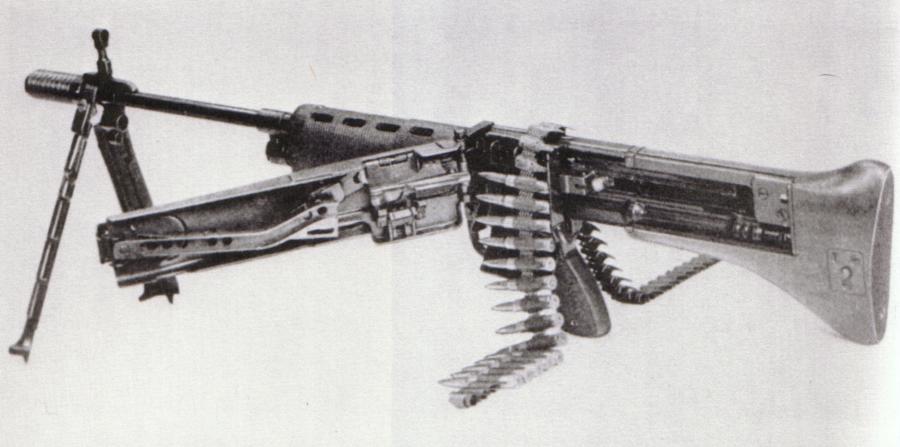
7.92mm Light Automatic Machine Gun T44 - Design Basis for the M60 GPMG Image credit: Senich, Peter, The German Assault Rifle 1939-1945, Paladin Press, Boulder, Colorado: 1987 Page 280 |
BIBLIOGRAPHY
Senich, Peter
R., The German Assault Rifle 1935-1945, (Paladin Press, Boulder,
Colorado: 1987)
The German
Assault Rifle
is available from IDSA Books. Click on the image
to order:
